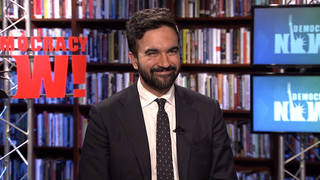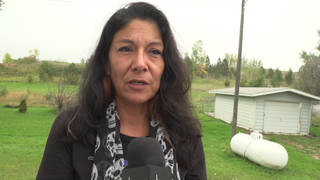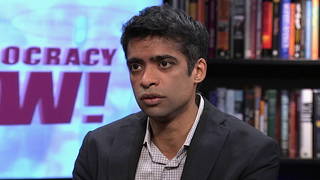
Guests
- Azmat Khanaward-winning investigative reporter, a New York Times Magazine contributing writer and a Future of War fellow at New America.
The U.S. has signed a deal with the Taliban aimed at drawing down its military presence and ending its 18-year war in Afghanistan. The long-anticipated deal comes after a year and a half of negotiations and following a week-long partial truce. Officials hope the accord will set the stage for a more detailed peace plan that creates a power-sharing arrangement and lasting ceasefire, but the deal did not include a key player: the U.S.-backed Afghanistan government. The Taliban has long refused to speak to the government, calling it a “puppet regime.” Under the deal, nearly 5,000 of the 12,000 U.S. troops still in Afghanistan will leave the country in 135 days. The rest of the troops will withdraw 14 months later, if the Taliban comply with the terms of the agreement. We discuss details of the deal with Azmat Khan, award-winning investigative reporter, a New York Times Magazine contributing writer and a Future of War fellow at New America.
Transcript
AMY GOODMAN: The U.S. has signed a deal with the Taliban aimed at drawing down its military presence and ending its 18-year war in Afghanistan. The long-anticipated deal comes after a year and a half of negotiations and following a week-long partial truce. Just one day after the accord was hailed as a major step in ending the longest war in U.S. history, it hit a roadblock Sunday when President Ashraf Ghani rejected a key stipulation that the Afghan government release 5,000 Taliban prisoners. The prison release is one of many conditions in a deal the United States and the Taliban signed Saturday in Doha, Qatar.
Officials hope the accord sets the stage for a more detailed peace plan that creates a power-sharing arrangement and lasting ceasefire, but the deal did not include a key player: the American-backed Afghanistan government. Intra-Afghan talks had been set for March 10th, but a Taliban spokesperson said Monday the Taliban refuse to participate unless the Afghan government releases the 5,000 Taliban prisoners outlined in the agreement. The Taliban has long refused to speak to the government, calling it a “puppet regime.”
More than 12,000 U.S. troops are still stationed in Afghanistan. Under the deal, nearly 5,000 of them will leave Afghanistan in 135 days. The rest will withdraw 14 months later, if the Taliban complies with the terms of the agreement. The deal also calls for the Taliban to cut ties with radical groups such as al-Qaeda and prevent them from launching attacks from Afghanistan. In turn, the United States will advocate for removing Taliban leaders from both U.S. and United Nations sanctions blacklists. In the agreement, the Taliban refused to accept the description of al-Qaeda as a terrorist, but committed to helping prevent future attacks. President Trump said Saturday the Taliban could be America’s newest partner in the so-called global war on terror.
PRESIDENT DONALD TRUMP: I’ll be meeting personally with Taliban leaders in the not-too-distant future and will be very much hoping that they will be doing what they say they’re going to be doing. They will be killing terrorists. They will be killing some very bad people. They will keep that fight going. We’ve had tremendous success in Afghanistan in the killing of terrorists, but it’s time, after all these years, to go and to bring our people back home. We want to bring our people back home.
AMY GOODMAN: Since the U.S. invaded Afghanistan nearly two decades ago, the U.N. estimates over 10,000 civilians were killed or injured from the ongoing conflict in 2019 alone. More than 100,000 civilians have been killed or injured over the past decade. Meanwhile, the United States’ stated goals remain largely unmet.
For more, we’re joined by Azmat Khan, an award-winning investigative reporter, New York Times Magazine contributing writer and a Future of War fellow at New America. Her investigations into U.S. wars have taken her to Iraq, Afghanistan, Pakistan and Syria. She’s currently writing a book about America’s so-called precision airstrikes.
Welcome back to Democracy Now! It’s great to have you with us, Azmat. So, talk about this deal that has just been brokered. I think it surprised many when President Trump came out to hold a coronavirus news conference but first began by revealing that this deal was being signed.
AZMAT KHAN: Well, 18 years into this war, this deal is clearly a breakthrough. It is something also that can and should have been done a long time ago, if you look at not just the lives lost in this war and you look at some of these things that happened. In 2001, for example, in October, before the United States had launched its invasion, Mullah Omar and some of the Taliban leadership had offered to turn over bin Laden to a third-party country, thereby averting this war altogether, and the Bush administration rejected that offer. Two months later into the bombing campaign, when the Taliban offered some kind of a negotiated settlement in which Mullah Omar would retain some sort of leadership in Kandahar and work out a negotiated settlement with the man who would become president, Karzai, Rumsfeld rejected it. There were several more times in which there were clear paths to a negotiated settlement that are far better than the deal we have today. But 18 years into this war, this is the best the United States could get, and it took it.
It’s not perfect. There are ambiguities in the plan. There are things that are not clearly spelled out. And it doesn’t mean that it will also ensure an end to violence. We’re likely to see — as long as the United States keeps funding the other side, we’re likely to see this violence continue and shift into new patterns. And so, it’s no guarantee by any means.
And at the same time, we have to look closely at what the U.S. is agreeing to. You know, they have made these claims that they’re going to withdraw American troops over time. And you really need to look at what the United States has done when faced with troop limits in this war and in other wars, is that they’ve often resorted to contractors to take up some of those roles that would otherwise be carried out by the U.S. military. One of the things that I’ve been looking at in recent years is the outsourcing of contracting, the outsourcing of airstrikes when it comes to contracting, the outsourcing of intelligence, things that allow the United States to continue the war while reducing its overt troop levels and sustaining that war with a sort of invisible army. And so, while there are about 12,000 U.S. troops in Afghanistan right now, there are also 26,000 contractors. So there’s a really big gap here that people need to watch.
AMY GOODMAN: So, what happens to those contractors?
AZMAT KHAN: It’s unclear. This deal doesn’t address that. It just addresses —
AMY GOODMAN: So, say the number of troops again.
AZMAT KHAN: There are 12,000 U.S. troops in Afghanistan.
AMY GOODMAN: And contractors?
AZMAT KHAN: Twenty-six thousand.
AMY GOODMAN: More than double.
AZMAT KHAN: Yes. Yes, there are more than that. And not only that, there are — 10,000 of those are Americans. Some are third-country nationals. Some are Afghan locals. But those are just the ones that are in country, that 26,000. There are many other contractors sitting in U.S. bases here, as well as in other bases across the world, who are involved in this war from abroad.
AMY GOODMAN: I don’t mean to sound cynical, but could this mean simply a 100% mercenary army left in Afghanistan?
AZMAT KHAN: It’s unclear if they’ll necessarily be on the ground in the ways that they were, that these sort of mercenaries, these contractors functioned in the past. What I think is more likely is that you’re likely to see the continued use of air power and contractors facilitating that. They’re already doing that right now. There are screeners on U.S. bases. And these are contractors who are doing this work, who are watching drone footage to basically give the calls for airstrikes. So, this is happening right now. And as troop levels decrease, you’re going to see a shift towards expanding that. So, in many ways, there are probably defense contractors who are salivating at the prospects for this right now.
AMY GOODMAN: I wanted to turn to the Afghan journalist Nargiss Hurakhsh, who is reacting to the news of the U.S.-Taliban accord.
NARGISS HURAKHSH: [translated] During the period of negotiations, the Taliban have repeatedly shown that their views on women have not changed, and this is a concern to us. We call on the Afghan government and the team who will negotiate with the Taliban to consider the freedom and achievements of all Afghans, especially women, as the bottom line.
AMY GOODMAN: So what about this? What about what will happen to women now?
AZMAT KHAN: So this question has been an enduring part of this war. In the lead-up to the War in Afghanistan, U.S. leaders used it as a rationale to build support for the war. And it was successful in doing that. But at the same time, it also manipulated this cause. You’ve seen the exploitation of women’s rights as a rationale for continuing and sustaining this war, this question of “What happens if we leave?”
The Taliban has not made significant gestures that show that it would take any — you know, as of today at least, they have not made any significant gestures that would show that they would allow for mass education for girls across the country. There isn’t any — there hasn’t been any clear guarantees, but it’s also not something that we’ve seen worked out publicly, either. So, you know, there are many women and girls in urban centers who have a lot to lose, and then there are many people in rural areas who basically fare the brunt of this war, who are basically trying to keep alive every day, who are victims of not just night raids and airstrikes, but also of Taliban attacks and land mines, who simply want to see some kind of a peaceful end.
So, you need to take the gender issue into account, certainly, but to mistake the idea that the United States has used that as an explicit military goal, that there are military officials sitting in a room arguing that this is why we’re at war, is really the exploitation of the women’s issue. This is not a real consideration when you’re looking at the military ambitions in Afghanistan.
AMY GOODMAN: It was quite something to hear President Trump saying the Taliban will be left to kill the terrorists.
AZMAT KHAN: This is related to the sort of question of the rise of ISIS in Afghanistan and of al-Qaeda in Afghanistan, these sort of affiliates that have emerged. And it’s fascinating, because you’ve essentially seen a fracturing of the Taliban and people who have splintered off into these other groups, which makes it a lot harder to negotiate across the board. And now you have groups that once you could have — they had been under the Taliban, that you could have negotiated with at once, that are now all of these different kinds of factions. The United States is struggling to try to figure out who to work with, who to talk to, how to go about even pursuing a deal like this, whether or not the people they’re talking to have the ability to carry out the agreements that are made, if that will filter down. And so, there are a lot of questions about the fracturing of this and whether you’ll see the United States try to create the idea of the good Taliban and the bad Taliban and foment those fissures further.
AMY GOODMAN: And who actually negotiated this deal in Doha, Qatar, for the United States and for the Taliban? And what does it mean that the Afghan government was not involved?
AZMAT KHAN: So, the main envoy here was — in these negotiations over the last year and a half has been Zalmay Khalilzad. And the Afghan government has been quite upset during this process, not just because they —
AMY GOODMAN: Zalmay Khalilzad, the former U.S. ambassador to Afghanistan, who is an Afghan American.
AZMAT KHAN: Absolutely, yes. He’s been involved in this war from very early on, on the American side. He is somebody who has pursued these negotiations much to the Afghan government’s chagrin. They are quite upset at their lack of involvement. There have been some extreme tensions between Khalilzad and the Afghan government, specifically over the deal struck. And you saw that most prominently with the question of detainees. And so, you know, there really needs to be some kind of a conversation between these negotiators, the Taliban and the Afghan government. And it will be interesting to see how that plays out over the next week.
AMY GOODMAN: Well, what about that, the 5,000-prisoner swap? The Afghan government says they are not agreeing to this. The Taliban says that they will not negotiate with the Afghan government if that prisoner swap doesn’t happen first.
AZMAT KHAN: That prisoner swap has been at the forefront of the Taliban’s agenda. And if you look at the history of this war and detention and the role it’s played, we’ve seen so many who have been detained, not just in Guantánamo and elsewhere, but Bagram, in these bases. They’re still being held today, and the Taliban would like to see these people returned. It’s been a critical point of issue. They struck some kind of — the language is actually quite vague in the agreement, and there’s even been arguments over what Khalilzad and U.S. representatives had said that they would negotiate with respect to detainees, saying that this would never be — a prisoner swap would never be on the table, and yet it materialized in this agreement. And so there are questions of how much buy-in there really is and whether something like that was — you know, if the Afghan government will match — will reciprocate that.
AMY GOODMAN: And finally, when is the ceremony going to take place that President Trump is going to have? The last one was called off. It was around September 11th. It was going to be at Camp David. What do you understand is happening now?
AZMAT KHAN: It’s unclear right now, in large part because of the fact that the Afghan government has responded in this way, which has really raised questions about what still needs to be worked out between the Taliban and the Afghan government. And so, it’s unclear exactly when we’ll see that actually materialize, but we do know that there’s a conversation that’s still out to happen.
AMY GOODMAN: Well, Azmat Khan, I want to thank you so much for being with us, award-winning investigative reporter, New York Times Magazine contributing writer, Future of War fellow at New America. Her investigations have led her to Iraq, Afghanistan, Pakistan and Syria, currently writing a book on the so-called U.S. precision airstrikes.
When we come back, we go to London. We’ll be joined by Julian Assange’s attorney. The judge has suspended extradition hearings of the WikiLeaks founder. He faces 175 years in prison in the United States if he’s sent here here, for exposing war crimes in Afghanistan and Iraq. Stay with us.












Media Options